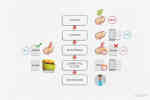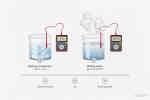Step 1 of 3•15 minutes read
Food Safety Management
Below are your keywords for this section of your training. These words you will use during your work and will appear in the final exam, so be sure you learn them.

Keywords
What is HACCP?
The HACCP concept was first developed in the 1960s by the U.S. National Aeronautics and Space Administration (NASA), working with Pillsbury, to ensure crumb- and pathogen-free food that had extensive shelf-life properties for space travel - the first pathogen monitoring and measurement requirement imposed on the food industry.
Food safety management is based on a system called HACCP. Hazards Analysis Critical Control Points. All vessels should have a system based on the principles of HACCP. (Ref: National Centre for Biotechnology Information)
A HACCP food safety management system is aimed at identifying and controlling significant food safety hazards BEFORE they cause harm. It is a proactive approach, complies with legal requirements, reduces the risk of food poisoning, and demonstrates management commitment.
HACCP is useful to demonstrate due diligence should an outbreak occur. This means that you, your team and your company have done everything you could possibly do to prevent an outbreak from occurring.
The food safety management on board can be part of the Vessel Sanitation Programme (VSP). In the United States, commercial ships are inspected twice a year under the VSP.
What are the prerequisites for HACCP?...
Prerequisite programmes are the range of fundamental control measures needed in order to produce safe food. Prerequisites are the basics of food hygiene and must be in place before a full HACCP system can be implemented. Without the following prerequisites, the safety of the food will not have a foundation and due diligence can not be proved.
Prerequisite Programmes
- Approved suppliers: Good reputable suppliers will have good food safety practices and will have traceability for all their produce.
- Good design of galleys and food preparation areas to allow for linear workflow and effective cleaning.
- Equipment calibration to ensure all temperatures that are shown are correct. For example probes and digital displays on fridges and freezers.
- Preventive maintenance will ensure that equipment and galleys do not physically contaminate food.
- Personal hygiene/competency training for all crew to prevent contamination of food.
- Stock rotation, so older food is used first and allows for effective cleaning.
- Cleaning and disinfection training for all food handlers to ensure bacteria do not survive.
- Pest management system preferably using a specialist company.
- Good housekeeping with clear SOP's and cleaning schedules.
- Waste management in line with MARPOL and food safety issues.
- Labelling and traceability of all products.
- Training of food handlers and crew on board so they understand their role in food safety.
Ships should implement a system of traceability. Traceability involves identifying the journey of a food product from farm to consumer. Records of all deliveries must be kept by caterers to ensure traceability, for example, in the event of food poisoning.
The Seven Principles of HACCP
All supervisors should hold level 3 food safety and be trained in HACCP. In your role as supervisor, you will be involved in all the stages of HACCP. There will be a fully trained HACCP team for your company who is responsible but you are accountable for your team and your areas of food safety management. You may be invited to become part of the HACCP team on board, if so it is highly recommended that you take the level 3 HACCP qualification as a minimum.
You will also make sure that the HACCP procedures work by regularly monitoring, observing and feeding back to your team.

The Seven Principles of HACCP
The flow diagram below explains the key steps after a hazard has been identified on the HACCP plan.
Firstly the hazard analysis has clearly identified a likely hazard. There needs to be a control to check this hazard by monitoring. If the monitoring proves that a critical limit is breached, there must be a clearly defined corrective action to ensure the food is rendered safe or disposed of.
You as the supervisor need to verify that the process is working.

Process
Date Codes on Food
A critical control for food safety is date codes. There are a number of dates that can be shown on foods so it is important you understand what they all mean.
- Sell by date: this is the date the product must be sold by.
- Best before: this is the date that food is at its best quality.
- Use by: this is the date the product MUST be used before, then it MUST be disposed of.
- Day dots: A day dot is put on a product by a food handler to show when the food MUST be disposed of.
Stock Rotation
Having a first in, first out system, for stock rotation ensures older stock is used first to reduce waste. Using older foods first will reduce the risk of food spoilage due to mould and slime. Stock rotation maintains correct stock levels for efficiency but most importantly it reduces pest infestations, as the stock is rotated and pests that are nesting will be disturbed.
HACCP from Delivery to Service
The illustrations below highlight key HACCP controls for all stages from delivery to service. HACCP (Food safety management) is developed and implemented by a qualified team. All food handlers need to understand their role within HACCP. Operationally two key points are part of the everyday work routine.
1. Critical Control Point: (shown in yellow in the illustration below) A critical control point is defined as a step at which control can be applied and is essential to prevent or eliminate a food safety hazard (something harmful or objectionable in food).
2. Critical Limit: (shown in green in the illustrations below) Critical limits are the values at critical control points (CCPs) that must be achieved to ensure the safety of food. They define "is this safe" and what decision to make to regain control for food safety, for example, Critical Temperatures and Time.



The video below is designed for you to test your understanding of how food should be stored in the fridge or walk-in cold store to prevent cross-contamination.
Watch this video to learn more about chilled food storage. Chilled food storage and display video from the food Standards Agency


Watch these videos to learn more:



Defrosting (Thawing of food)
The safest way to defrost food is to defrost it in a fridge for over 24 hrs not at room temperature in the danger zone.
All food should be defrosted thoroughly and cooked within 24 hours. Defrosted raw food can not be frozen again it must be cooked or disposed of within 24 hours.
Monitoring
Monitoring is a check to make sure that controls are in place and working. Ways to monitor include:
- Measuring (for example taking temperatures).
- Observation (for example checking deliveries or date codes).
- Using the senses (for example smell or look of food).
If monitoring identifies that control has not worked, make sure you report it to your supervisor. It is important to implement the right corrective action to bring the situation under control again.
Thermometers - Use and Calibration
A digital, electronic probe thermometer (thermocouple or thermistor) should be used to measure storage and cooking temperatures. The core temperature is usually at the centre of the thickest part of the food.
Probe thermometers should be validated (calibrated) regularly. Electronic calibration test caps may be used to check the accuracy of some types of thermometers. Each probe should be numbered and the result of the validation should be recorded.
Probes which are more than 1°C adrift should be replaced.
The image below shows how to calibrate a thermocouple probe. Plunge the probe into iced water and reset the probe to read 0°C or do the same into boiling water and reset it to 100°C. Kindly note that the iced water method is more reliable.

Thermometers
Mistakes when Taking Food Temperatures
- The thermometer is not calibrated therefore the wrong temperature is displayed.
- Not taken at core temperature. If taken at the side of the food the reading will be hotter the core may still be cold.
- Not cleaning and disinfecting probes will cause cross-contamination between raw and cooked food.
- Not allowing sufficient time for the reading to stabilise.
- Touching bone/container, the pan, for example, will give a false reading of the food's core temperature.
- Recording Fahrenheit as Celsius is often a mistake 75°F is only 23°C which is the temperature bacteria grow most rapidly.
Here are some links to useful videos:
- Keeping food separate from the food standards agency
- Keeping food covered from the food standards agency.
- Chilling food from the food standards agency.
- Reheating food from the food standards agency.
The video below highlights some of the main day-to-day activities of a supervisor.